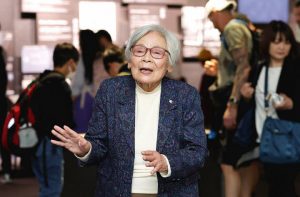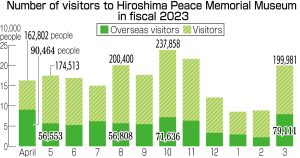One year after G7 Hiroshima Summit, “achievements” in question, Part 1: Call for understanding of Hiroshima’s origins
Apr. 19, 2024
by Keiichi Nobira, Staff Writer
May 19 this year marked the first anniversary of the summit meeting of the G7 (Group of Seven industrialized nations) held in Hiroshima, the first G7 summit meeting held in an A-bombed city. The summit provided an opportunity to raise awareness about Hiroshima, still scarred by the horror of the atomic bombing but hoping for a peaceful world without nuclear weapons. However, internationally, conflicts between nuclear weapons states persist. What did the G7 Hiroshima Summit achieve? Herein, the Chugoku Shimbun looks into the current situation.
Scenes of the Hiroshima Peace Memorial Museum, in Hiroshima’s Naka Ward, crowded with visitors has become familiar. Early this month as well, people of different nationalities and ages, including students on school excursions, came face-to-face with the tragedy that happened 79 years ago, viewing the clothes A-bomb victims had worn at the time, burnt lunchboxes, and other exhibit items.
Henry Cordes, 65, a tourist from Germany, forced the words from his lips and said that he was deeply touched by the videos of testimonies from A-bomb survivors who had lost their children or family members in the bombing. Regarding the summit meeting held a year ago, Mr. Cordes wondered what the world leaders were feeling after seeing the exhibits.
On May 19 last year, the summit’s first day, leaders from the G7 nations, including the nuclear powers of the United States, the United Kingdom, and France, as well as the president of the European Union (EU) together visited the museum. After touring the exhibits, they left messages in the museum’s guestbook calling for peace and “a world without nuclear weapons.”
What the leaders observed at the museum in fact was only a handful of materials, which had been gathered on the third floor of its East Building, with the specifics of their reaction not disclosed to the public. However, since that time, crowds of people have surged to the museum from Japan and overseas, as if inspired by the leaders’ visit. Last summer, waiting times to enter the museum reached a maximum of two hours. In fiscal 2023, the number of visitors to the museum hit a record high of 1,981,782 people, including 670,757 people from overseas, which was a new record for their number and percentage among total visitors.
Shiro Tani, vice chairperson of the Hiroshima Peace Culture Foundation, the organization that manages the museum, summarized the situation over the past 12 months. “Expectations for and interest in Hiroshima as an international city of peace and culture have grown,” said Mr. Tani. He views the reasons for the increased interest in the A-bombed city as being the relaxed measures against the coronavirus, the effects of a weak yen, and the increased tension in the world that just happened to follow the summit.
Mr. Cordes was saddened by the conflicts that persist in the world, including the intensifying chaos in the Middle East. He explained his feeling that the summit was only politically symbolic, but added that it was important how people in Japan and around the world would gain interest in the issue of nuclear weapons by taking advantage of the opportunity presented by the summit.
A-bomb survivors, who have continued to convey their message from the A-bombed Hiroshima, continue to seek out paths they should take. One such survivor is Yasuko Kondo, 83, a resident of Nishi Ward who shared her A-bombing experience with international journalists during the summit period. Ms. Kondo said, “It was a positive that the summit brought attention from the world, but I don’t think that should be the end of it.”
Ms. Kondo has served as a “peace volunteer,” offering tours as a guide of the monuments located within Peace Memorial Park, since 2000. But she has not had the chance to communicate her experience in the atomic bombing or guide visitors since the end of the summit due to being in and out of the hospital. Whenever she comes into contact with news of war in other nations with scenes of children fleeing here and there, she recalls her experience in the bombing. She said, “No more A-bomb survivors, with their terribly painful experiences, should ever be created again. I want people to see the museum.” Ms. Kondo continues her walking practice with the aim of resuming her activities sometime this year.
The Peace Memorial Museum is replete with the origins of the A-bombed Hiroshima. The G7 Summit shed light anew on the museum’s appeal. Next year marks the 80th anniversary of the atomic bombing. With the aging of the A-bomb survivors, who have spoken of their hope for peace while suffering both physically and psychologically, the museum’s power to communicate is more significant than ever.
Keywords
Summit meeting of the Group of Seven industrialized nations (G7 Summit)
The G7 Summit is held annually in a rotation of chair countries—the nuclear powers of the U.S., the U.K., and France and the nations reliant on the U.S. nuclear umbrella of Japan, Germany, Italy, and Canada—with the European Union (EU) also participating. In 2023, the Japanese government hosted the summit in Hiroshima during the period May 19–21. The summit’s itinerary included visits to Peace Memorial Park, located in Hiroshima’s Naka Ward, and Miyajima Island, in Hatsukaichi City, Hiroshima Prefecture. The summit put together what is called the “Hiroshima Vision,” the first consensus document of the summit focused on nuclear disarmament, showing the intention to achieve “a world free of nuclear weapons” in a realistic and practical manner while at the same time affirming the framework of nuclear deterrence. Leaders from nine nations, including India, South Korea, and Ukraine, as well as heads of international organizations were invited to participate in the extended summit meeting.
(Originally published on April 19, 2024)
May 19 this year marked the first anniversary of the summit meeting of the G7 (Group of Seven industrialized nations) held in Hiroshima, the first G7 summit meeting held in an A-bombed city. The summit provided an opportunity to raise awareness about Hiroshima, still scarred by the horror of the atomic bombing but hoping for a peaceful world without nuclear weapons. However, internationally, conflicts between nuclear weapons states persist. What did the G7 Hiroshima Summit achieve? Herein, the Chugoku Shimbun looks into the current situation.
Waves of people from Japan and overseas continue to arrive
Importance grows of Peace Memorial Museum’s power to communicate
Scenes of the Hiroshima Peace Memorial Museum, in Hiroshima’s Naka Ward, crowded with visitors has become familiar. Early this month as well, people of different nationalities and ages, including students on school excursions, came face-to-face with the tragedy that happened 79 years ago, viewing the clothes A-bomb victims had worn at the time, burnt lunchboxes, and other exhibit items.
Henry Cordes, 65, a tourist from Germany, forced the words from his lips and said that he was deeply touched by the videos of testimonies from A-bomb survivors who had lost their children or family members in the bombing. Regarding the summit meeting held a year ago, Mr. Cordes wondered what the world leaders were feeling after seeing the exhibits.
On May 19 last year, the summit’s first day, leaders from the G7 nations, including the nuclear powers of the United States, the United Kingdom, and France, as well as the president of the European Union (EU) together visited the museum. After touring the exhibits, they left messages in the museum’s guestbook calling for peace and “a world without nuclear weapons.”
What the leaders observed at the museum in fact was only a handful of materials, which had been gathered on the third floor of its East Building, with the specifics of their reaction not disclosed to the public. However, since that time, crowds of people have surged to the museum from Japan and overseas, as if inspired by the leaders’ visit. Last summer, waiting times to enter the museum reached a maximum of two hours. In fiscal 2023, the number of visitors to the museum hit a record high of 1,981,782 people, including 670,757 people from overseas, which was a new record for their number and percentage among total visitors.
Shiro Tani, vice chairperson of the Hiroshima Peace Culture Foundation, the organization that manages the museum, summarized the situation over the past 12 months. “Expectations for and interest in Hiroshima as an international city of peace and culture have grown,” said Mr. Tani. He views the reasons for the increased interest in the A-bombed city as being the relaxed measures against the coronavirus, the effects of a weak yen, and the increased tension in the world that just happened to follow the summit.
Mr. Cordes was saddened by the conflicts that persist in the world, including the intensifying chaos in the Middle East. He explained his feeling that the summit was only politically symbolic, but added that it was important how people in Japan and around the world would gain interest in the issue of nuclear weapons by taking advantage of the opportunity presented by the summit.
A-bomb survivors, who have continued to convey their message from the A-bombed Hiroshima, continue to seek out paths they should take. One such survivor is Yasuko Kondo, 83, a resident of Nishi Ward who shared her A-bombing experience with international journalists during the summit period. Ms. Kondo said, “It was a positive that the summit brought attention from the world, but I don’t think that should be the end of it.”
Ms. Kondo has served as a “peace volunteer,” offering tours as a guide of the monuments located within Peace Memorial Park, since 2000. But she has not had the chance to communicate her experience in the atomic bombing or guide visitors since the end of the summit due to being in and out of the hospital. Whenever she comes into contact with news of war in other nations with scenes of children fleeing here and there, she recalls her experience in the bombing. She said, “No more A-bomb survivors, with their terribly painful experiences, should ever be created again. I want people to see the museum.” Ms. Kondo continues her walking practice with the aim of resuming her activities sometime this year.
The Peace Memorial Museum is replete with the origins of the A-bombed Hiroshima. The G7 Summit shed light anew on the museum’s appeal. Next year marks the 80th anniversary of the atomic bombing. With the aging of the A-bomb survivors, who have spoken of their hope for peace while suffering both physically and psychologically, the museum’s power to communicate is more significant than ever.
Keywords
Summit meeting of the Group of Seven industrialized nations (G7 Summit)
The G7 Summit is held annually in a rotation of chair countries—the nuclear powers of the U.S., the U.K., and France and the nations reliant on the U.S. nuclear umbrella of Japan, Germany, Italy, and Canada—with the European Union (EU) also participating. In 2023, the Japanese government hosted the summit in Hiroshima during the period May 19–21. The summit’s itinerary included visits to Peace Memorial Park, located in Hiroshima’s Naka Ward, and Miyajima Island, in Hatsukaichi City, Hiroshima Prefecture. The summit put together what is called the “Hiroshima Vision,” the first consensus document of the summit focused on nuclear disarmament, showing the intention to achieve “a world free of nuclear weapons” in a realistic and practical manner while at the same time affirming the framework of nuclear deterrence. Leaders from nine nations, including India, South Korea, and Ukraine, as well as heads of international organizations were invited to participate in the extended summit meeting.
(Originally published on April 19, 2024)









